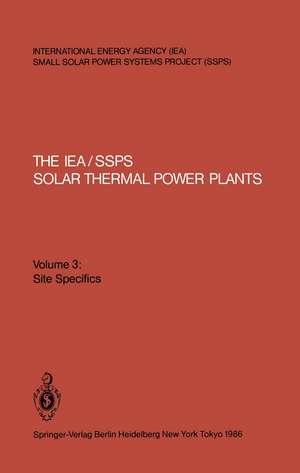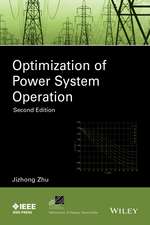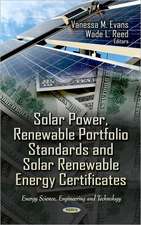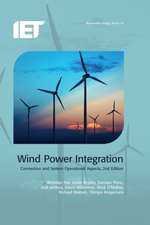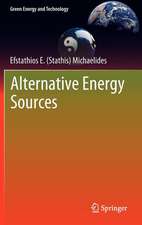The IEA/SSPS Solar Thermal Power Plants: Facts and Figures
Editat de Paul Kesselring, Clifford S. Selvageen Limba Engleză Paperback – feb 1986
| Toate formatele și edițiile | Preț | Express |
|---|---|---|
| Paperback (2) | 635.80 lei 6-8 săpt. | |
| Springer Berlin, Heidelberg – feb 1986 | 635.80 lei 6-8 săpt. | |
| Springer Berlin, Heidelberg – 31 ian 1986 | 651.34 lei 6-8 săpt. |
Preț: 635.80 lei
Preț vechi: 748.00 lei
-15% Nou
Puncte Express: 954
Preț estimativ în valută:
121.67€ • 132.12$ • 102.21£
121.67€ • 132.12$ • 102.21£
Carte tipărită la comandă
Livrare economică 22 aprilie-06 mai
Preluare comenzi: 021 569.72.76
Specificații
ISBN-13: 9783540161486
ISBN-10: 3540161481
Pagini: 204
Ilustrații: VIII, 192 p. 10 illus.
Dimensiuni: 155 x 235 x 11 mm
Greutate: 0.29 kg
Ediția:Softcover reprint of the original 1st ed. 1986
Editura: Springer Berlin, Heidelberg
Colecția Springer
Locul publicării:Berlin, Heidelberg, Germany
ISBN-10: 3540161481
Pagini: 204
Ilustrații: VIII, 192 p. 10 illus.
Dimensiuni: 155 x 235 x 11 mm
Greutate: 0.29 kg
Ediția:Softcover reprint of the original 1st ed. 1986
Editura: Springer Berlin, Heidelberg
Colecția Springer
Locul publicării:Berlin, Heidelberg, Germany
Public țintă
ResearchCuprins
1. Introduction.- 2. Site Description.- 3. Meteorological Conditions.- 3.1 SSPS Meteorological Conditions 1982–1984.- 4. Environmental Conditions / Reflectivity.- 4.1 Environmental Conditions Impacts on Solar Mirrow Reflectivity.- 4.2 Method for Estimating the Reflectivity Distribution.- 5. Soiling.- 5.1 Dust Analysis.- 5.2 Soiling Effects: Coating Investigations.- 5.3 Contents of Volumes I, II, and III.
Descriere
Descriere de la o altă ediție sau format:
The Project's origin As a consequence of the so-called "first oil crisis", the interest in solar electricity generation rose sharply after 1973. The solar ther mal way of solving the problem was attractive because the main task was simply to replace the fossil fuel by a "solar fuel" in an other power plant -that was at least what many wise conventional thermal thought at that time. Thus more than half a dozen of solar thermal plant projects were created in the mid-seventies. One of them is the Small Solar Power Systems (SSPS) Project of the International Energy Agency (lEA). It consists of the design, development, construction, operation, test and evaluation of two dissimilar small solar thermal electric power systems each at a nominal power of 500 kW . e ITET and TOAB In order to assist the Operating Agent (DFVLR - Deutsche Forschungs und Versuchsanstalt fUr Luft- und Raumfahrt e. V. ) in managing the project, the Executive Committee (EC) created two bodies called the "International Test and Evaluation Team" (ITET) and the "Test and Operation Advisory Board" (TOAB). The latter consisted of a group of experts from the different participating countries, meeting three to four times a year to articulate i. a. the technical interests and expectations of the different parties in the project. It was the TOAB that formulated e. g.
The Project's origin As a consequence of the so-called "first oil crisis", the interest in solar electricity generation rose sharply after 1973. The solar ther mal way of solving the problem was attractive because the main task was simply to replace the fossil fuel by a "solar fuel" in an other power plant -that was at least what many wise conventional thermal thought at that time. Thus more than half a dozen of solar thermal plant projects were created in the mid-seventies. One of them is the Small Solar Power Systems (SSPS) Project of the International Energy Agency (lEA). It consists of the design, development, construction, operation, test and evaluation of two dissimilar small solar thermal electric power systems each at a nominal power of 500 kW . e ITET and TOAB In order to assist the Operating Agent (DFVLR - Deutsche Forschungs und Versuchsanstalt fUr Luft- und Raumfahrt e. V. ) in managing the project, the Executive Committee (EC) created two bodies called the "International Test and Evaluation Team" (ITET) and the "Test and Operation Advisory Board" (TOAB). The latter consisted of a group of experts from the different participating countries, meeting three to four times a year to articulate i. a. the technical interests and expectations of the different parties in the project. It was the TOAB that formulated e. g.
